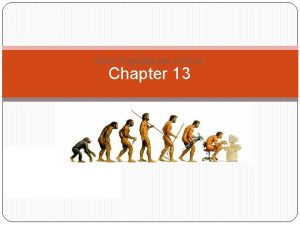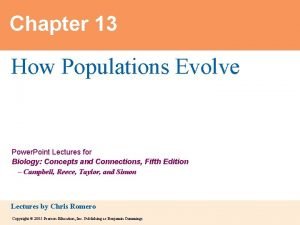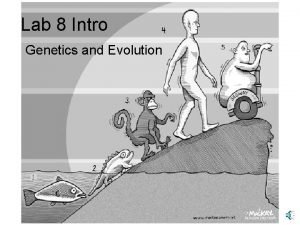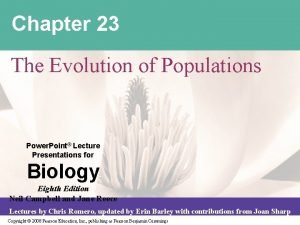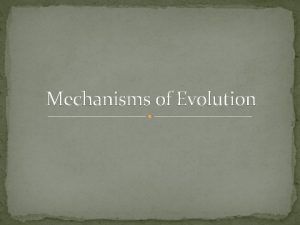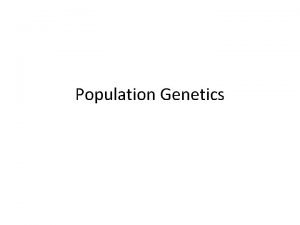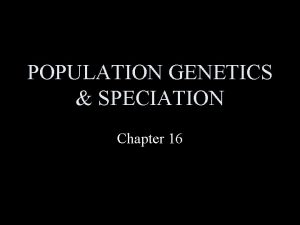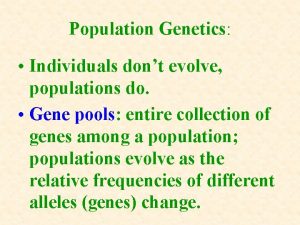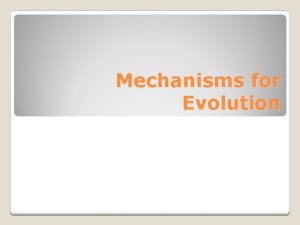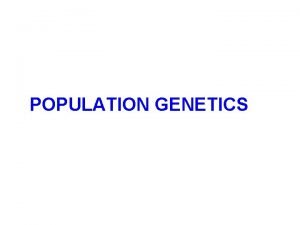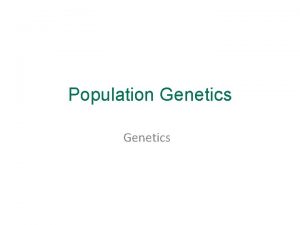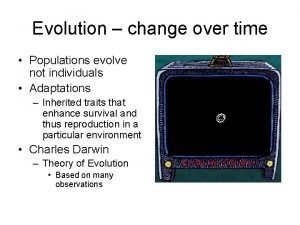Mechanisms of Evolution Population Genetics Populations evolve not











- Slides: 11

Mechanisms of Evolution

Population Genetics • Populations evolve, not individuals • Natural Selection acts on a range of phenotypes in the population • Gene Pool – All the combinations of the 2 alleles that make up a gene that are available in the population • Allelic frequency – Percentage of any specific allele in the gene pool (ratios)

Change in gene frequency to measure evolution • Evolution only occurs when there is a change in gene frequency within a population over time. These genetic differences are heritable and can be passed on to the next generation—

Mechanisms of change #1 • Mutation • A mutation could cause parents with genes for bright green coloration to have offspring with a gene for brown coloration. That would make the genes for brown beetles more frequent in the population

Mechanisms of change #2 • Migration also known as gene flow Some individuals from a population of brown beetles might have joined a population of green beetles. That would make the genes for brown beetles more frequent in the green beetle population

Mechanisms of change #3 • Genetic Drift Imagine that in one generation, two brown beetles happened to have four offspring survive to reproduce. Several green beetles were killed when someone stepped on them and had no offspring. The next generation would have a few more brown beetles than the but just by chance previous generation—. These chance changes from generation to generation are known as genetic drift.

Mechanisms of change #4 • Natural Selection Imagine that green beetles are easier for birds to spot (and hence, eat). Brown beetles are more likely to survive to produce offspring. They pass their genes for brown coloration on to their offspring. So in the next generation, brown beetles are more common than in the previous generation.

Natural selection a closer look • Of the four mechanisms of change only natural selection is adaptive…. that means that the individual that are in the population are better suited to the environment.

Types of Natural Selection • Stabilizing Selection – Favors average individuals – Example: • Spiders • Small – Difficult to find food • Large – easy to see = get eaten • Medium – likely to survive

Directional Selection • Favors one of the extremes – Example: • Woodpecker beaks • Insects live deeper in the tree • Birds with longer beaks will get the food and survive • Short and medium will die

Disruptive selection • Favors either extreme – Example: • • Limpet color: white, dark or tan On Light or dark rocks they blend in Predators easily see tan on both dark and light rocks Both white and dark extremes survive
 Individuals don't evolve populations do
Individuals don't evolve populations do Chapter 13 how populations evolve test
Chapter 13 how populations evolve test Chapter 13 how populations evolve
Chapter 13 how populations evolve Similar
Similar Evolution of populations section 16-1 genes and variation
Evolution of populations section 16-1 genes and variation Chapter 16 evolution of populations vocabulary review
Chapter 16 evolution of populations vocabulary review Chapter 17 evolution of populations answer key
Chapter 17 evolution of populations answer key Chapter 23: the evolution of populations
Chapter 23: the evolution of populations Evolution of populations section 16-1 genes and variation
Evolution of populations section 16-1 genes and variation Chapter 16 evolution of populations
Chapter 16 evolution of populations Evolution of populations section 11 review
Evolution of populations section 11 review Chapter 23 the evolution of populations
Chapter 23 the evolution of populations

